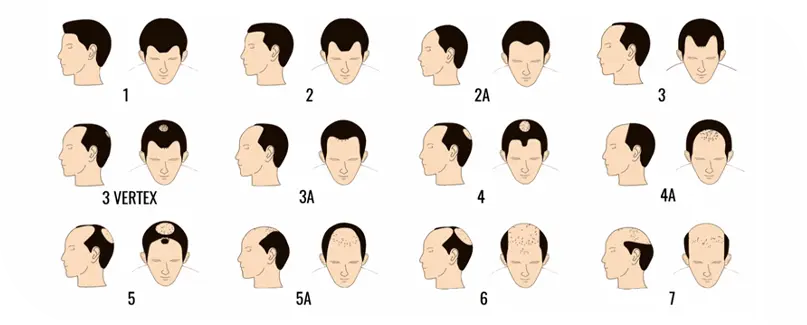The Norwood Hair Scale
The Norwood Hair Scale is a crucial reference in understanding male pattern baldness, offering a detailed framework to assess the progression of hair loss. From early signs of receding hairlines to advanced balding, this scale categorizes hair loss into specific stages, helping both individuals and hair restoration specialists gauge the severity of the condition. By providing a standardized method to measure and discuss hair loss, the Norwood Scale plays a vital role in diagnosing and tailoring treatment plans, ensuring that each approach is as effective and personalized as possible.
Table of Contents
ToggleIntroduction to the Norwood Hair Scale
The Norwood Hair Scale, also known as the Hamilton-Norwood Scale, is a standardized classification system used to measure the extent of male pattern baldness. Developed initially by Dr. James Hamilton in 1951 and later refined by Dr. O’Tar Norwood in 1975, this hair scale is widely utilized by dermatologists and hair clinics. It provides a standardized method to diagnose the severity of androgenic alopecia, facilitating more precise treatment planning.
History and Development of the Norwood Hair Scale
The Norwood Hair Scale was developed by Dr. Hamilton and expanded in 1975 by Dr. Norwood. It is the measurement used by dermatologists and hair clinics to indicate how serious the hair loss is in androgenic alopecia and in which areas it occurs, to determine the treatment with greater precision.
How the Norwood Hair Scale Works
The Norwood Hair Scale categorizes hair loss into stages, ranging from 1 to 7, with further subtypes. These stages help in identifying the progression of hair loss and are crucial in determining appropriate treatments.
Benefits of the Norwood Hair Scale
The Norwood Hair Scale not only shows your hair loss level but also helps in classifying hair loss levels in degrees from 1 to 7, with 12 different loss types. In addition to determining the level of your hair loss, it provides an approximate idea of the type of treatment that should relate to your hair loss. If the hair loss is in a high stage, it may be troublesome to win your hair with pharmaceuticals. In such cases, hair transplantation might be necessary.
Causes and Onset of Male Pattern Baldness
Male alopecia usually has genetic and hormonal causes, although certain nutritional deficiencies or times of stress can also play a role. If it is due to these last two causes, it will be male alopecia but of the telogen effluvium type. Hair loss typically manifests after the age of 20, though it can appear at younger ages, and with advancing age, it can affect up to 80% of the male population. Capillary density begins to be lost in the frontal and temporal areas (entrances) and continues in the crown. The hair follicles in these areas are more sensitive to androgens, hormones that cause progressive miniaturization until they disappear.
Hair Loss Stages According to the Norwood Hair Scale
1: Minimal or No Hair Loss
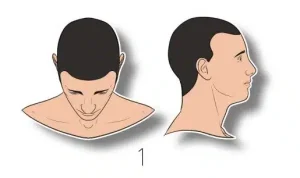
- Description: The hairline remains at its original position with no significant recession.
- Characteristics: No visible hair loss, hair spreads evenly and thickly on the scalp.
2: Slight Recession of the Hairline
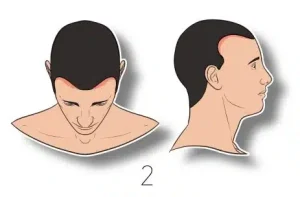
- Description: The hairline begins to recede slightly, typically at the temples.
- Characteristics: Early signs of hair loss, with a V-shaped or M-shaped hairline.
3: Early Hair Loss
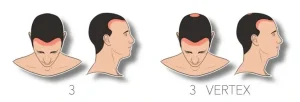
- Description: The hairline recedes more noticeably, forming a deeper V-shape at the temples.
- Characteristics: Hair loss becomes apparent to the patient and others, with thinning or bald areas on the frontal scalp and/or vertex.
4: Advanced Recession
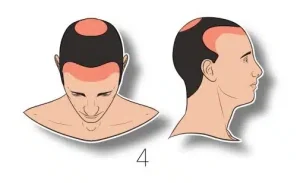
- Description: Further recession at the temples, with significant hair loss on the vertex (crown).
- Characteristics: A small area of hair might remain at the front, but the vertex starts to show more pronounced baldness.
5: Significant Hair Loss
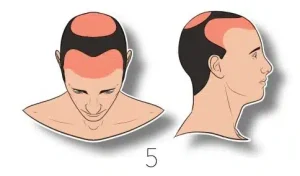
- Description: The bridge of hair between the receding hairline and the vertex begins to thin.
- Characteristics: The hair loss pattern resembles stage 4 but with more extensive thinning. The bridge of hair separating the front and top may still be present but is sparse.
6: Bridge Disappears
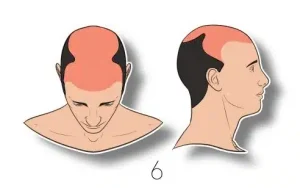
- Description: The hair loss at the temples joins with the bald area on the vertex.
- Characteristics: The top of the head becomes mostly bald, with hair loss extending around the crown. Only a sparse ring of hair around the sides and back remains.
7: Most of the Hair Has Been Lost
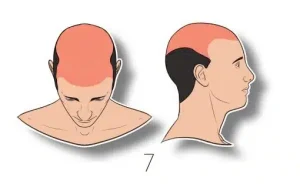
- Description: This is the most severe stage of hair loss, with only a thin band of hair around the sides and back of the head.
- Characteristics: The hair is very sparse and fine, with the top of the head completely bald. The remaining hair around the sides and back may also be thin and sparse.
Norwood Class A
Norwood Class A is a less common variation of the Norwood scale that depicts a different progression of hair loss. In this variation, the hairline recedes uniformly without leaving an island of hair in the center. Additionally, there is no bald area at the vertex; instead, the hairline recedes directly from the front to the back.
Measuring Baldness on the Norwood Hair Scale
Step-by-Step Guide to Measuring Baldness
Initial Consultation
- Purpose: To understand the patient’s concerns and hair loss history.
- Actions: Discuss when the hair loss started, any family history of baldness, and any treatments previously tried.
Visual Examination
- Purpose: To assess the visible pattern and extent of hair loss.
- Actions: The doctor or specialist visually examines the scalp, focusing on the hairline, temples, and crown.
Identify the Hair Loss Pattern
- Purpose: To determine the specific areas where hair is thinning or balding.
- Actions: Look for recession at the temples, thinning at the crown, and overall hair density.
Determine the Norwood Stage
- Purpose: To categorize the severity of hair loss accurately.
- Actions: Assign the patient to the corresponding stage on the Norwood Hair Scale based on the observed pattern.
Document Findings
- Purpose: To keep a record for future reference and treatment planning.
- Actions: Take photographs and notes on the current stage and any noticeable changes over time.
Discuss Treatment Options
- Purpose: To inform the patient about potential treatments based on their Norwood Hair Scale stage.
- Actions: Recommend appropriate treatments such as medications, lifestyle changes, or surgical options like hair transplantation.
Female Pattern Baldness and the Norwood Hair Scale
The Norwood scale is specifically designed to measure male pattern baldness and is not typically used for assessing hair loss in women. Women usually experience a different pattern of hair loss, which is better categorized by the Ludwig scale or the Savin scale.
Ludwig Scale
The Ludwig scale is a commonly used classification system for female pattern baldness. It divides hair loss into three main types:
- Type I: Mild thinning that can be camouflaged with hair styling techniques. The hair loss is mainly on the crown with a widening of the parting line.
- Type II: Increased thinning and noticeable hair loss. The parting line continues to widen, and there may be visible thinning on the top of the scalp.
- Type III: Diffuse thinning across the top of the scalp, often exposing the scalp. Hair loss is extensive and very noticeable.
Savin Scale
The Savin scale is similar to the Ludwig scale but includes an additional parameter for measuring overall hair density. It also ranges from mild to severe thinning and includes a total of eight stages:
- Stage 1-2: Minimal thinning, barely noticeable.
- Stage 3-4: Moderate thinning with visible widening of the part.
- Stage 5-6: Advanced thinning with significant hair loss, part line is very wide.
- Stage 7-8: Severe thinning, scalp is visible through the hair.
Progression from Stage 3 to Stages 6 or 7 on the Norwood Hair Scale
It is possible for someone at the third degree of baldness on the Norwood scale to experience further hair loss and progress to a more advanced stage, such as stage 6 or 7. Male pattern baldness (androgenic alopecia) is typically a progressive condition, meaning hair loss can worsen over time without intervention.
Factors Influencing Progression
- Genetics: Family history of baldness can be a strong indicator of how your hair loss might progress.
- Hormonal Changes: Increased levels of dihydrotestosterone (DHT) can accelerate hair loss.
- Age: Hair loss tends to progress with age.
- Lifestyle and Health: Diet, stress, and overall health can impact the rate of hair loss.
Preventing or Slowing Progression
While it may not be possible to completely stop hair loss, certain treatments can slow down the progression and help maintain existing hair:
- Medications: Minoxidil (Rogaine) and finasteride (Propecia) can help stimulate hair growth and slow hair loss.
- Hair Transplant Surgery: Options like FUE and FUT can restore hair in balding areas.
- Lifestyle Changes: Maintaining a healthy diet, reducing stress, and regular check-ups can help manage hair loss.
When to Consider a Hair Transplant
The decision to undergo a hair transplant is highly individual and depends on various factors, including the extent of hair loss, the availability of donor hair, and personal goals.
General Recommendations for Hair Transplant Based on Norwood Hair Scale
Stage 1 and 2: We typically do not recommend hair transplant surgery at this stage. You might want to consider non-surgical treatments like minoxidil or finasteride to slow progression.
Stage 3: We can consider hair transplant surgery if hair loss significantly distresses you or impacts your self-esteem.
Stage 4: Individuals commonly consider hair transplant surgery at this stage. Combining transplant surgery and medical treatments can effectively restore hair density.
Stage 5: We often recommend hair transplant surgery at this stage. A specialist will evaluate your donor area’s density and overall scalp health toplan the procedure.
Stage 6: We commonly perform hair transplant surgery at this stage, though it may require multiple sessions to achieve the desired density and coverage.
Stage 7: Hair transplant surgery may pose challenges due to limited donor hair. A specialist will assess the feasibility and may suggest alternative treatments or a more conservative approach to transplantation.
How is Hair Loss Treated?
Hair loss can be treated through a variety of methods, ranging from over-the-counter (OTC) treatments to prescription medications. The approach depends on the severity and pattern of hair loss, as well as individual preferences and medical history.
Over-the-Counter (OTC) Treatments
OTC treatments are readily available and can be a first step for those experiencing hair loss. These treatments are typically less expensive and easier to access compared to prescription medications.
Minoxidil (Rogaine)
- Description: Minoxidil is a topical treatment that is applied directly to the scalp. It is available in liquid or foam forms.
- How it works: Minoxidil helps to stimulate hair growth by increasing blood flow to hair follicles and prolonging the growth phase of the hair cycle.
- Usage: It is usually applied twice daily to the scalp in the areas of thinning hair.
- Effectiveness: It can take several months to see noticeable results, and continuous use is necessary to maintain hair growth.
Ketoconazole Shampoo
- Description: Ketoconazole is an antifungal shampoo that can help reduce scalp inflammation and improve hair health.
- How it works: By reducing dandruff and seborrheic dermatitis, ketoconazole helps create a healthier environment for hair growth.
- Usage: It is typically used 2-3 times a week as a regular shampoo.
- Effectiveness: While not a primary treatment for hair loss, it can be an effective adjunct therapy.
Prescription Treatments
For more significant hair loss or when OTC treatments are not effective, prescription medications may be necessary. These treatments are often more potent and require a doctor’s supervision.
Finasteride (Propecia)
- Description: Finasteride is an oral medication that is specifically used to treat male pattern baldness.
- How it works: It works by inhibiting the enzyme 5-alpha reductase, which converts testosterone to dihydrotestosterone (DHT). DHT is a hormone that shrinks hair follicles, leading to hair loss.
- Usage: It is taken once daily as a pill.
- Effectiveness: Clinical studies have shown that finasteride can significantly slow hair loss and promote regrowth in many men. However, its effects are reversible if the medication is discontinued.
Dutasteride (Avodart)
- Description: Dutasteride is similar to finasteride but inhibits both types of 5-alpha reductase enzymes, potentially making it more effective.
- How it works: By reducing DHT levels more significantly than finasteride, dutasteride can help prevent hair follicle miniaturization.
- Usage: It is taken orally, typically once daily.
- Effectiveness: Studies have shown dutasteride to be effective in treating male pattern baldness, often with more pronounced results than finasteride.
corticosteroids
Description: You can use corticosteroids to treat hair loss caused by inflammatory scalp conditions.
How they work: They reduce inflammation and suppress the immune system response that can lead to hair loss.Usage: You can administer them as topical creams, oral medications, or injections directly into the scalp.
Effectiveness: Corticosteroids can be effective in conditions like alopecia areata, where inflammation plays a significant role.
Other Treatments
In addition to OTC and prescription medications, there are other treatments available for hair loss.
Hair Transplant Surgery
- Description: Hair transplant surgery involves moving hair follicles from a donor area (typically the back of the scalp) to the balding or thinning areas.
- Types: Common methods include Follicular Unit Transplantation (FUT) and Follicular Unit Extraction (FUE).
- Effectiveness: This can provide permanent and natural-looking results but is a more invasive and costly option.
Platelet-Rich Plasma (PRP) Therapy
- Description: PRP therapy involves injecting the patient’s own platelet-rich plasma into the scalp to promote hair growth.
- How it works: The growth factors in the plasma can stimulate hair follicles and promote regrowth.
- Usage: It typically involves multiple sessions over several months.
- Effectiveness: Some studies suggest PRP can be effective, particularly when combined with other treatments.
By understanding the various treatment options available, individuals experiencing hair loss can make informed decisions and choose the best course of action in consultation with their healthcare provider.
Conclusion
Understanding the Norwood Hair Scale is essential for managing and treating male pattern baldness effectively. Regular consultations with a hair restoration specialist can help monitor progression and tailor treatment plans to your specific needs. Early intervention with medical treatments can slow down hair loss, while advanced stages may benefit from surgical options to restore hair density and improve overall appearance. By staying informed and proactive, you can take control of your hair loss and explore the best solutions for maintaining a healthy scalp and hair.
This comprehensive guide provides all the information needed to understand and use the Norwood Hair Scale effectively, ensuring informed decisions about hair loss and treatment options.

